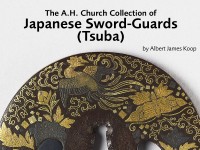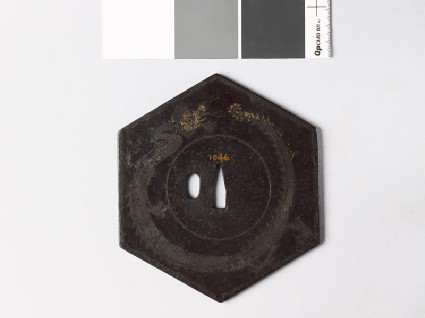The A. H. Church Collection of Japanese Sword-Guards (Tsuba)
An unpublished catalogue of the A. H. Church collection of Japanese sword-guards (tsuba) by Albert James Koop.

Publications online: 1264 objects
Hexagonal tsuba with dragon and peonies
-
Literature notes
Hexagonal; polished surface; on the front inlaid silver wire marks out an inner circle and the spine of a large dragon coiled almost into a ring, the rest of him being in silver nunome, with gold head and tail; at the back similar wires mark out an inner circle and a wavy scrolled stem, which has five peony flowers and numerous leaves in silver nunome; a narrow border is marked on the front by a single silver wire inlaid, at the back by a wave pattern of numerous wires. Signed: Miōchin Nobuiye kore wo tsukuru (compare Group IVa), and dated Tenshō XIII (1586). The decoration is Hizen (Nagasaki) work, probably of the 17th century.
One of the largest old tsuba known; the holes for the tang and kodzuka are not, however, of abnormal size. The "inlaying" of the silver wires might almost be described as nunome (compare Introduction). -
Details
- Associated place
- Date
-
forged 1586
probably decorated 17th century (1601 - 1700)
- Material and technique
- iron, with polished surface (migaki-ji), inlaid with silver wire, and with gold and silver nunome-zōgan decoration
- Dimensions
- 14.5 x 12.7 cm (height x width)
- Material index
-
processed material › metal › iron,processed material › metal › gold,
- Technique index
- Object type index
-
arms/armour › koshirae › kodogu › tsuba
- No. of items
- 1
- Credit line
- Bequeathed by Sir Arthur H. Church, 1915.
- Accession no.
- EAX.10842
-
Further reading
Koop, Albert James, The A. H. Church Collection of Japanese Sword-Guards (Tsuba), 3 vols (Oxford, Ashmolean Museum, 1929), no. 842
Glossary (2)
nunome-zōgan, tsuba
-
nunome-zōgan
Decorative application of metal sheeting (generally of gold or silver) where the iron ground is first cross-hatched and the metal burnished on.
-
tsuba
Japanese sword guard.
Location
-
- currently in research collection
Objects are sometimes moved to a different location. Our object location data is usually updated on a monthly basis. Contact the Jameel Study Centre if you are planning to visit the museum to see a particular object on display, or would like to arrange an appointment to see an object in our reserve collections.
Publications online
-

The A. H. Church Collection of Japanese Sword-Guards (Tsuba)
Hexagonal; polished surface; on the front inlaid silver wire marks out an inner circle and the spine of a large dragon coiled almost into a ring, the rest of him being in silver nunome, with gold head and tail; at the back similar wires mark out an inner circle and a wavy scrolled stem, which has five peony flowers and numerous leaves in silver nunome; a narrow border is marked on the front by a single silver wire inlaid, at the back by a wave pattern of numerous wires. Signed: Miōchin Nobuiye kore wo tsukuru (compare Group IVa), and dated Tenshō XIII (1586). The decoration is Hizen (Nagasaki) work, probably of the 17th century.
One of the largest old tsuba known; the holes for the tang and kodzuka are not, however, of abnormal size. The "inlaying" of the silver wires might almost be described as nunome (compare Introduction).
Notice
Object information may not accurately reflect the actual contents of the original publication, since our online objects contain current information held in our collections database. Click on 'buy this publication' to purchase printed versions of our online publications, where available, or contact the Jameel Study Centre to arrange access to books on our collections that are now out of print.
© 2013 University of Oxford - Ashmolean Museum

